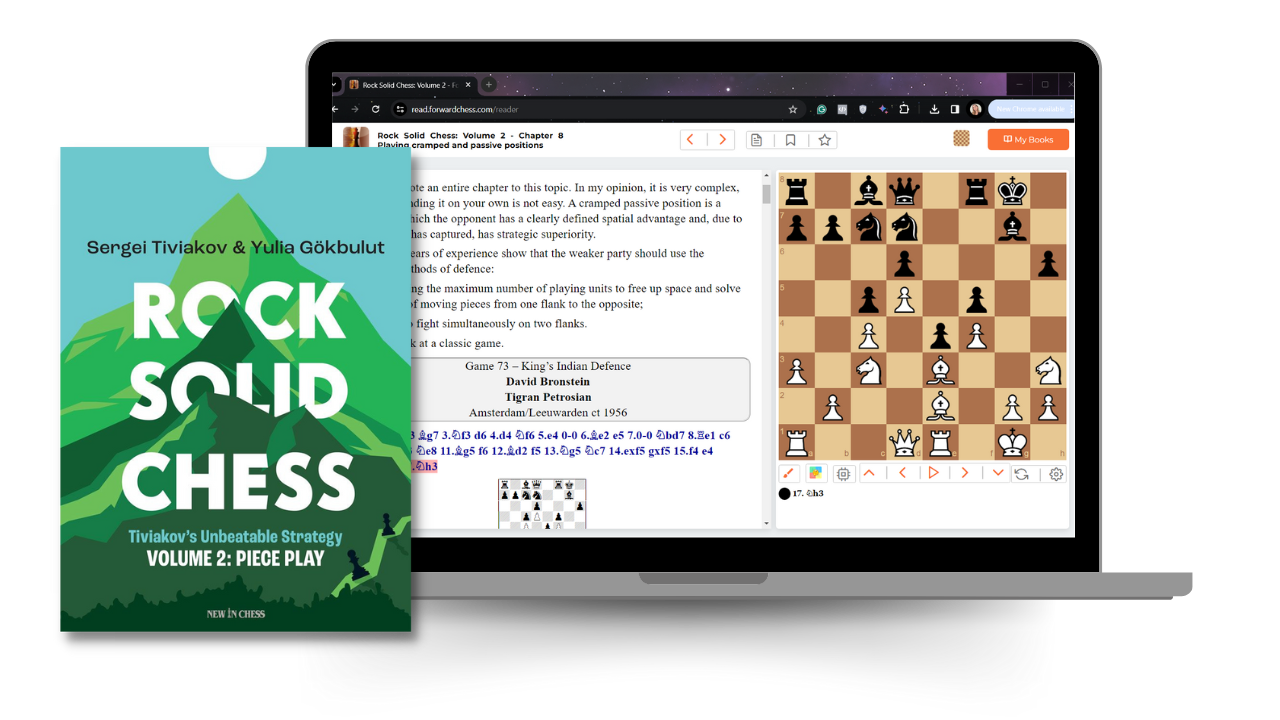When “Rock Solid Chess” entered the chess literature scene, it immediately made waves. Our Forward Chess users loved it (as we spoke about in our “Best of 2023” Blog Post), and readers around the world loved it too, so much so that it was awarded the Yuri Averbakh/Isaac Boleslavsky Award by FIDE for the best book published in 2022. If you haven’t heard of this award yet, just know that it’s a BIG deal.
Now in 2024, authors Sergey Tiviakov and Yulia Gokbulut released the second book in the three-book series – Rock Solid Chess Volume 2: Piece Play. What does this book have to offer, and will it live up to the expectations of its predecessor? Let’s explore!

The first book in this strategy series dealt with pawn structures, and as the name suggests, the second one continues the strategic exploration with piece play. Topics include the bishop pair, opposite-coloured bishops, centralization, and considerations on castling. The authors delve into the dynamic value of pieces based on their positions, strategy selection influenced by psychological factors, and handling cramped or passive positions.

Let’s take a look at Chapter 8: Playing cramped and passive positions. I think that we can all agree that these types of positions are not the easiest to play, and sometimes it can be difficult to think of a way forward. Add time trouble to this dilemma, and you might find yourself losing a game too many. It’s all fun and games solving quick tactics and getting that instant gratification of rating gain, but the real work is done through topics such as this.
Tiviakov discusses it in the chapter intro:

This is followed by a classic game between Bronstein and Petrosian (no, not the blunder game) that showcases how Petrosian neutralized his opponent’s space advantage:
1.c4 g6 2.Nc3 Bg7 3.Nf3 d6 4.d4 Nf6 5.e4 O-O 6.Be2 e5 7.O-O Nbd7 8.Re1 c6 9.d5 c5 10.a3 Ne8 11.Bg5 f6 12.Bd2 f5 13.Ng5 Nc7 14.exf5 gxf5 15.f4 e4 16.Be3 h6 17.Nh3
White has a large spatial advantage due to the d5-pawn, which takes away a significant number of squares from the opponent. White can easily maneuver his pieces, moving them from one flank to the other, while his opponent is deprived of this opportunity.
Question: How can Black play so as to avoid simultaneous play on both flanks?
Answer: 17…Bxc3
This is a clean example of how exchanges can be used to prevent the opponent becoming active on one flank. (The same game is examined in Chapter 1, where it is suggested that according to my computer 17…Bxc3 is not the strongest move. But Petrosian’s simple human decision to reduce the play on the board only to the king flank accords with both points of our rules of play in passive positions.)
Question: If Black had not played 17..Bxc3, then what plan could White have executed on the queenside?
Answer: White’s plan would be the encircling pawn advance b4, Nf2, h3, g4.
18.bxc3
But after this exchange, the area of battle is restricted to one flank only.
18…Nf6 19.a4 Kh8 20.Nf2 Rg8 21.Kh1 Qe8 22.Rg1 Qg6 23.Qd2 Bd7 24.g3 Rae8 25.a5 Re7 26.Rab1 Bc8 27.Rg2 Reg7 28.Rbg1 Nce8 29.h3 h5 1/2-1/2
Go through the whole game, and other examples from the chapter, in the book’s free sample:
And don’t miss out on the book’s limited New Release Special Discount on the Forward Chess webstore.

- The Power of Pattern Recognition: The Woodpecker Method 2 - August 20, 2024
- Rock Solid Chess: Volume 2 - February 21, 2024
- Unsung Heroes of Chess - February 19, 2024
